|
June 1935 Short Wave Craft
 [Table
of Contents] [Table
of Contents]
Wax nostalgic about and learn from the history of early electronics. See articles
from Short Wave Craft,
published 1930 - 1936. All copyrights hereby acknowledged.
|
Here for radio hobbyists are
eleven handy-dandy "kinks," otherwise known as tricks, shortcuts, or clever ideas,
that could prove useful while working in the lab at work or in your shop at home.
This set appeared in the June 1935 issue of Short Wave Craft magazine.
Some of the ideas presented are timeless, but admittedly, most of these ideas would
not have much application with today's ready-made radios, antennas, power supplies,
etc. There are still people, though, who build custom equipment and/or repair vintage
equipment who might find them useful. The most relevant kink offered here that could
come in handy for anybody is to clip off part of a closed ring terminal lug to allow
it to be installed and uninstalled without needing to remove the cinching nut and
possibly other lugs also on the same binding post.
$5.00 for Best Short-Wave Kink
The Editor will award a five dollar prize each month for the best short-wave
kink submitted by our readers. All other kinks accepted and published will be awarded
eight months' subscription to Short Wave Craft. Look over these "kinks" and they
will give you some idea of what the editors are looking for. Send a typewritten
or ink description, with sketch, of your favorite short-wave kink to; the
"Kink" Editor, Short Wave Craft.
$5.00 Prize
New Transposition Ring
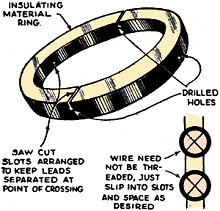 This is what I use for transposition blocks.
They are rings cut from any kind of insulating material that will stand the weather.
A whole set can be made in a short time with a handsaw and miter box. This is what I use for transposition blocks.
They are rings cut from any kind of insulating material that will stand the weather.
A whole set can be made in a short time with a handsaw and miter box.
Just saw them off a tube, then cut them square across on each side. If preferable,
you can bore a hole in the bottom of the cut to be sure the wire won't slip out.
They have:
1. The very minimum of material so they should be low loss.
2. All sides push to the center when there is a strain on them so they won't
buckle.
3. Costs practically nothing.
4. The wire doesn't have to be threaded through holes - can be put on anywhere.
- Alex D. Snider.
Fly-Cutter
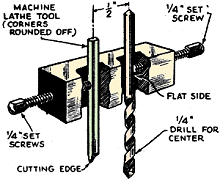 Here is a fly-cutter constructed from easily
obtained parts. It consists of a piece of 1/2'' stock 1 1/2" long and drilled as
shown in diagram. One 1/4" machine lathe tool, two 1/4" set screws and a 1/4" drill
make up the rest of the parts necessary. The drill is ground flat on one side to
receive the set screw to prevent slipping. As you see it has no adjustment and is
used to cut 1 1/4" holes for tube sockets. It is very efficient and rids us of the
annoying slippage of adjustment in factory-made cutters. Here is a fly-cutter constructed from easily
obtained parts. It consists of a piece of 1/2'' stock 1 1/2" long and drilled as
shown in diagram. One 1/4" machine lathe tool, two 1/4" set screws and a 1/4" drill
make up the rest of the parts necessary. The drill is ground flat on one side to
receive the set screw to prevent slipping. As you see it has no adjustment and is
used to cut 1 1/4" holes for tube sockets. It is very efficient and rids us of the
annoying slippage of adjustment in factory-made cutters.
- Arnold Forsman.
Varnish Can as Shield
 Here is how to save money in building a
monitor or other short-wave apparatus requiring a shield post. An old varnish can
is just the thing for the job, being of the right size and shape. One may encounter
difficulties in cleaning it; however, this can be done with turpentine or other
paint-removers solutions. The first step is to cut off the handle and the spout;
then proceed to cut a hole in the narrow side large enough to admit the batteries.
Be sure to provide for a smooth edge around this hole so that you will not cut yourself
on the rough or sharp edges. The opening should be fitted with a lead as shown in
the drawing. After the can has been made over as desired, it can be given a coat
of black enamel, or some other artistic decoration can be applied. Here is how to save money in building a
monitor or other short-wave apparatus requiring a shield post. An old varnish can
is just the thing for the job, being of the right size and shape. One may encounter
difficulties in cleaning it; however, this can be done with turpentine or other
paint-removers solutions. The first step is to cut off the handle and the spout;
then proceed to cut a hole in the narrow side large enough to admit the batteries.
Be sure to provide for a smooth edge around this hole so that you will not cut yourself
on the rough or sharp edges. The opening should be fitted with a lead as shown in
the drawing. After the can has been made over as desired, it can be given a coat
of black enamel, or some other artistic decoration can be applied.
- Calvin Sloan.
Improving Key Handle
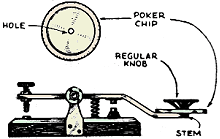 By simply drilling a hole in the center
of a poker chip, and placing it between the button and stem of your key, you have
a semi-Navy type knob which is very easy to handle. The added poker chip flange
gives more pressure and leverage during both the upward and downward stroke. (This
system has been used in conjunction with the 500-watt transmitter at W6XBY since
'33) By simply drilling a hole in the center
of a poker chip, and placing it between the button and stem of your key, you have
a semi-Navy type knob which is very easy to handle. The added poker chip flange
gives more pressure and leverage during both the upward and downward stroke. (This
system has been used in conjunction with the 500-watt transmitter at W6XBY since
'33)
- S. R. Radom, Opr.
Code Practice Kink
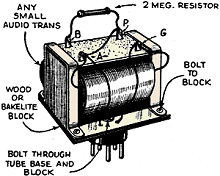 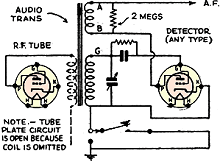 Many of the readers of Short Wave Craft
who desire to practice code without the cost of building an entirely separate audio
oscillator can accomplish this very easily by building the unit described in the
drawings. It consists of an audio transformer on which has been mounted a tube base.
The number of prongs conforms with the number of prongs on your plug-in coils, and
the entire instrument plugs into the coil socket, the same as your short-wave coils.
A diagram is also shown and indicates where the key may be inserted. Many of the readers of Short Wave Craft
who desire to practice code without the cost of building an entirely separate audio
oscillator can accomplish this very easily by building the unit described in the
drawings. It consists of an audio transformer on which has been mounted a tube base.
The number of prongs conforms with the number of prongs on your plug-in coils, and
the entire instrument plugs into the coil socket, the same as your short-wave coils.
A diagram is also shown and indicates where the key may be inserted.
- John W. Dietrich.
Cement Mixture
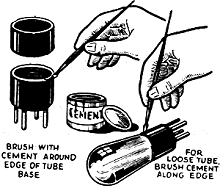 In making coil forms by cementing tube base
together, I could not find a suitable cement and the coil forms soon fell apart.
After much experiment I found a mixture which answered the purpose very well. In making coil forms by cementing tube base
together, I could not find a suitable cement and the coil forms soon fell apart.
After much experiment I found a mixture which answered the purpose very well.
It is made by mixing together two parts of ether and one part of alcohol, both
of which can be obtained at any near-by drug store. To the mixture of alcohol and
ether, celluloid chips are added and allowed to stand in a corked bottle overnight.
In the morning if the solution is still watery, add more chips and let stand
again. When a thick liquid is formed it will be ready for us. Making coil forms
is not its only use for it can be used for holding the wire in place on spaced coils,
fastening tubes that have become loosened from their bases and thousands of other
uses.
- Theodore Zukauskas.
Variable Antenna Coupler
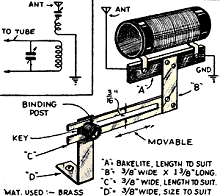 Many fans would like to use an antenna coupling
coil instead of the usual capacitive coupling used in most receivers. The diagram
clearly shows how a mounting bracket can be constructed which will allow varying
the coupling for different short-wave bands. It is also advisable to use the condenser
in series with the coil and the antenna in order to make use of what tuning may
be possible. Many fans would like to use an antenna coupling
coil instead of the usual capacitive coupling used in most receivers. The diagram
clearly shows how a mounting bracket can be constructed which will allow varying
the coupling for different short-wave bands. It is also advisable to use the condenser
in series with the coil and the antenna in order to make use of what tuning may
be possible.
- Daniel Borneman.
Substitute for Key Contacts
 The contacts for keys or relays can be replaced
when worn by substituting the used contacts from almost any type of automobile distributor. The contacts for keys or relays can be replaced
when worn by substituting the used contacts from almost any type of automobile distributor.
The discarded points can usually be obtained from your local garage. After cleaning
and a little filing, when soldered to the key or relay, they become a serviceable
contact about 3/16 inch in diameter.
The contact No. 1 is found only on Ford Model A and AA and serves well as the
adjustable contact for a telegraph relay.
Many of the readers of Short Wave Craft who hare burned off the contacts of their
keys or relays will find this kink very useful and the new contacts will stand up
for a very long time, because of the hardness of them and if sufficient filter is
used to suppress the spark.
- H. W. Crouter.
Handle for Plug-In Coils
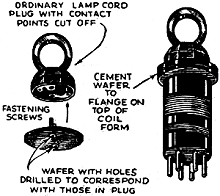 Here is a simple way to use attachment plugs
as handles for plug-in coils. Saw off the projecting prongs and then cut a small
disc from a piece of 1/8 inch hard rubber or bakelite as shown in the diagram. After
this has been fastened to the attachment plug, cement the whole thing to the top
of the plug-in coil - with household cement or - some other such material Here is a simple way to use attachment plugs
as handles for plug-in coils. Saw off the projecting prongs and then cut a small
disc from a piece of 1/8 inch hard rubber or bakelite as shown in the diagram. After
this has been fastened to the attachment plug, cement the whole thing to the top
of the plug-in coil - with household cement or - some other such material
- George Mostacello.
Low Current Relay
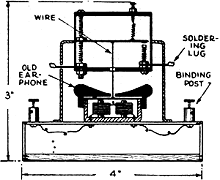 Here is my radio kink. It is a simple relay
that can be made in about one hour. Most of the parts can be found in your junk
box. It can be used for many things; it will make a motor go by means or a beam
of light. or course, you hare to have other parts, amplifier, etc. It will do what
any other sensitive relay can do. Here is my radio kink. It is a simple relay
that can be made in about one hour. Most of the parts can be found in your junk
box. It can be used for many things; it will make a motor go by means or a beam
of light. or course, you hare to have other parts, amplifier, etc. It will do what
any other sensitive relay can do.
- Paul R. Schmidt.
Handy Bench Light
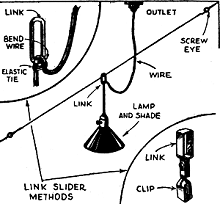 Many experimenters have difficulty in obtaining
sufficient light for their workbench without using a very powerful bulb. This can
be overcome by stretching a piece of No. 14 wire across the length of the workbench
and attaching an old fixture ring as shown in the drawing; the entire lamp can then
be slid from one end of the bench to the other and will enable you to have a light
where you want it. The drawing clearly Many experimenters have difficulty in obtaining
sufficient light for their workbench without using a very powerful bulb. This can
be overcome by stretching a piece of No. 14 wire across the length of the workbench
and attaching an old fixture ring as shown in the drawing; the entire lamp can then
be slid from one end of the bench to the other and will enable you to have a light
where you want it. The drawing clearly
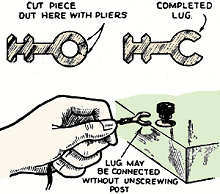 shows how a separate clamp can be made if
one desires to go to the extra trouble. Another useful kink that I have used quite
often is also shown among the drawings. when you have a closed connecting lug and
you wish to overcome the necessity of removing the binding post nut each time, it
is only necessary to cut out a section of the lug with a pair of diagonal pliers
or tin snips. shows how a separate clamp can be made if
one desires to go to the extra trouble. Another useful kink that I have used quite
often is also shown among the drawings. when you have a closed connecting lug and
you wish to overcome the necessity of removing the binding post nut each time, it
is only necessary to cut out a section of the lug with a pair of diagonal pliers
or tin snips.
- Russell Bulger.
Posted January 26, 2024
(updated from original
post on 3/20/2017)
|













